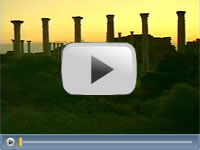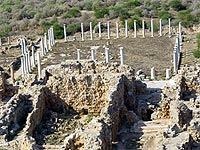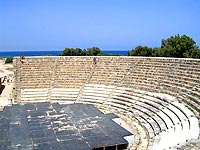
Salamis ruins in Famagusta, North Cyprus.
 |
the north cyprus travel guide |
 |
|
Salamis Ruins
Salamis was the most important ancient city in Cyprus, and the ruins are still impressive today. Set over a site over one kilometre long, and with a sandy beach along the entire length of the site, Salamis is a great place for a day out in North Cyprus. Allow plenty of time; to walk the entire site is a trek of almost 5km! Early History of SalamisLegend tells how Salamis was originally founded by a hero from the Trojan War, Teucer, son of the King of Salamis. The city flourished, and was soon minting its own coinage. The citizens of Salamis resisted the Persian invasion during the fifth century BC, and helped Alexander the Great. However, the last king of Salamis committed suicide and burned his palace to the ground rather than submit to the Egyptian king Ptolemy I in 295BC. Salamis is a must-see place during your holiday in North Cyprus. The Roman Remains of Salamis
The remains we see to day at Salamis are from the Roman period, when Salamis was the main commercial centre of Cyprus. Salamis was a base for early Christianity, as the Apostle Barnabus lived and died in the city. In 116AD the Jews in Salamis revolted, and as a result all Jews were expelled from Cyprus. When the Byzantines took over Cyprus, Salamis became the capital of the island, but the combined disasters of earthquakes and tidal waves in the fourth century, Arab raids in the seventh century and the gradual loss of the harbour due to silt from the river meant that nearby Famagusta grew in prominence. Salamis fell into decline, with medieval builders raiding the site for building stone. The remains at Salamis in North Cyprus today
The site of ancient Salamis was first excavated in 1882, but after the main excavations stopped in 1974, much of the site still remains to be uncovered from the sand dunes that have spread across the deserted city. The mains features of Salamis ruins are spread over the area of the site, so be sure to take a hat and a bottle of water in the summer. There is shade from the trees are you walk around, but not much! Salamis in North Cyprus: the GymnasiumThe gymnasium complex was a school and modern-style wellbeing centre rolled into one. It is marked by elegant porticeos, which still have their Byzantine mosaic pavements but the marble statues have all lost their heads. The western colonnade was reassembled in the 1950s after earthquake damage, but the mismatch of columns dates from the Byzantine period. The Byzantines didn't care much if columns matched or not, so they just raided spare ones as replacements from elsewhere in Salamis! Behind the gymnasium are the latrines, accommodating up to 44 in one sitting! Salamis in North Cyprus: the Roman baths
The original Roman baths were remodelled by the Byzantines, but you can still see the plunge pools of the caldarium, or cold room. Only rediscovered in 1926, the original hot room was at the east end of the hall. Underneath its restored pool you can see some mosaics with floral and geometric designs.The south hall of the baths has the best mosaics, one featuring the legend of Leda and the swan, and another depicting a hunting scene, possibly with Apollo at the centre. These are late mosaics dating from the early fourth century, just before Christianity became adopted officially by the Roman authorities. Salamis in North Cyprus: the amphitheatreThe amphitheatre at Salamis originally held over 15,000 people, and it's still an impressive site from the very top of its restored eighteen rows of stone seats (there were originally 50 rows). Part of a complex that included the odean (a concert venue) and possibly a small stadium, the amphitheatre is host to open air performances during the summer months.
Salamis in North Cyprus: the basilicasWalking down the main path into the heart of the site, you pass a Roman villa before reaching the Ayios Epifanios basilica, which is marked by the stumps of its once towering pillars. This was once the largest basilica in Cyprus. Just opposite, the pile pink granite columns originally from Aswan in Egypt, mark the site of a second forum, Towards the sea at the far end of the site is the Kambanopetra (Campana Petra) basilica, which originally housed the sarcophagi of important church dignitaries, and whose white marble still glistens in the bright North Cyprus sunshine. Beyond the basilica are the jumbled remains of another bathhouse, which has one of the best mosaics in Salamis, a circular floor of black and white triangles that make the eyes go dizzy! Salamis in North Cyprus: the forumA 56km long aquaduct brought water from Kythrea to a vast Byzantine cistern which sat beside the Roman forum, holding sufficient water for the needs of 120,000 people. Presiding over the forum, thought to be the largest in the entire Roma Empire, was the Temple of Zeus. You only fully appreciate how important this area was in early times when you realise that just across the main road are the Royal Tombs, the Bronze Age village of Enkomi and the St Barnabas Monastery! |
|
North Cyprus quick: holidays | flights | hotels | property | kyrenia | famagusta | photos | map | weather | history | news
All text is copyrighted by Cyprus44. Photographs are copyrighted by their respective photographers.
For more information read our copyright policy, privacy policy and disclaimer.
This web page is served on 29 March 2025 at 12:30:19 PM.
![]()
Cyprus44 in other languages: Nordzypern | Chypre Nord | Severní Kypr | Северный Кипр
partner sites: goNorthCyprus Travel | Pacific Rent-A-Car | Amy Holiday Villas | other partner sites













